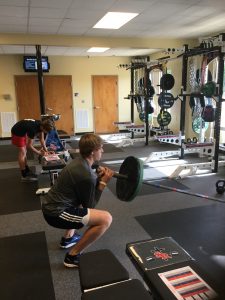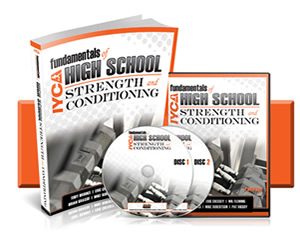Front Squat Progression
When I started working as a high school strength and conditioning coach after 15 years in college S & C, the importance of proper progressions took on a whole new meaning to me. Not only are progressions critical to development, but the safety aspect simply cannot be understated. The primary movements I have selected for our high school strength & conditioning program are the Pause Bench Press, Front Squat, and Power Clean. In this article I will be covering the Front Squat Progression I use in our program. 
Each step in the front squat progression progression takes 6-9 weeks, with each exercise building into the next. With almost two decades of coaching at multiple levels, and working with thousands of athletes, I feel that utilizing these progressions sets our athletes up for long-term success and safety.
In the last portion of the article, I will discuss how we incorporate areas that impact our squat progressions along with some of the issues a coach may encounter when implementing a system with these types of progressions.
While the goal of a high school strength and conditioning program is help prepare athletes for their chosen sport, as much as I hate to say it, lifting weights is not the main priority for most young athletes. The reason they train is to get stronger, faster, more agile, and more flexible in an effort to excel in their sport. With that in mind, the last thing we want is an athlete getting injured inside the weight room because of improper training. Using progressions helps ensure we are building the in right direction.
In our high school strength & conditioning program, the Front Squat is our staple exercise for developing lower body strength. In my opinion, the Front Squat is the best option for strengthening the lower body for athletes. As a former powerlifter, I have a fondness for the back squat. but I have found that, when dealing with youth and high school age athletes, the Front Squat holds more benefit and significantly less risk than the traditional back squat exercise.
With all primary movements, we start with isometrics, then we focus on mastering body weight exercises, followed by partial range of motion movements with external load, and finally full range of motion exercises. Our squat progressions are as follows:
Isometric Athletic Hold
I like this exercise to begin the front squat progression as it can be taught to any age and any training level. It is the fundamental athletic position which all athletes should master. Starting here gives the coach many different directions to go when it comes to training.
Sets & Reps: 4-6 sets, starting with 20 second holds working up to 60 second holds.
Video of Iso Athletic Hold
Isometric Wall Squat
This is an easy transition from the Isometric Athletic Hold. When performing this exercise, focus on proper depth. We get the thigh parallel to the ground.
Sets & Reps: 4-6 sets, starting with 30 seconds holds working up to 60 second holds.
Video of Iso Wall Squat
TRX Squat
This exercise is our first non-isometric movement. This TRX Squat is easy to perform and really allows the athlete to feel how to hinge at the hips and sit back. We coach the athlete to go as low as possible, which can vary depending upon many different issues. In this case we operate with “the lower the better mentality” and since it isn’t a loaded movement, unless there is a pre-existing condition, athletes should not have an issue performing this exercise with a full range of motion.
Sets & Reps: 4-6 sets, starting with 6 reps and working up to 10 reps.
Video of TRX Squat
Body Weight Box Squat
This is a great exercise for teaching the hinge of the hips, proper posture and positioning, and feeling what it is like to hit proper depth when performing a squat. When performing this exercise, a box of 12-15 inches will be used for most athletes depending on their height.
Sets & Reps: 4-6 sets, starting with 8 reps working up to 12 reps.
Video of Body Weight Box Squat
Goblet Squat
This is the first exercise in our front squat progression that utilizes an external load. By now, the athlete should be proficient at hinging at the hip, maintaining good posture throughout the movement, and understand proper squat depth. Start with a light weights and gradually progress, always making sure that proper technique is being used.
Sets & Reps: 4-6 sets, starting with 6 reps working up to 10 reps.

Core Blaster Squat
This exercise is one I recently added and have really seen a lot of benefit from performing. While it’s like the Goblet Squat in many ways, the use of the Core Blaster adds a different stimulus to the exercise, along with being able to significantly increase the load used during the lift.
Sets & Reps: 4-6 sets, starting with 6 reps working up to 10 reps.

Overhead Squat
We begin the Overhead Squat using a PVC pipe, and progress to using a barbell for those who can properly execute the movement. Maintaining great posture and body control during this exercise is critical to the execution of the movement. Mastering this movement is vital to properly set up the athlete for success in our following exercises.
Sets & Reps: 4-6 sets, starting with 5 reps working up to 8 reps.
Video of Overhead Squat
Free Weight Squat
This exercise is the most challenging of all the exercises within our front squat progression. It is also the most uncomfortable for new lifters. The Free Weight Squat is great for teaching the proper position of the barbell in the “rack” position of the front squat, or “catch” on the power clean. This is also a great exercise to emphasize proper hip hinge and posture during the squat. If the arms drop, the chest follows, then the barbell begins to drop. Depending on the age of the athlete, we may start with a PVC pipe then work up to the barbell.
Sets & Reps: 4-6 sets, starting with 5 reps working up to 8 reps.
Video of Free Weight Squat
Front Squat
This is the final stage in our Front Squat progression. As was stated earlier, we believe that the Front Squat is the best squat for an athlete to perform when attempting to improve athletic performance.
Video of Front Squat
This is our complete Front Squat Progression. We believe this progression prepares athletes for the demands that will be placed upon them in our program. Another important aspect of our program is that we super-set just about every exercise. We do this for a couple of reasons:
- We have very limited time during the class day and super-setting allows us to increase the overall volume of work we can do during that time. Some days, we only have 25 minutes during class so we must figure out how to be productive with that type of schedule.
- Super-sets are a simple way to spend time on the commonly neglected areas of the body. This allows us to work on wrist mobility, core work, neck strengthening, and muscular balance for the upper & lower extremities.
- It is a straightforward way to build training density. We increase our overall workload over time, not only in our primary movements, but also in our super-setted movements.
Many athletes want to rush the early stages of our front squat progression. In my experience, if there is a frustration or complaint by an athlete, it stems from either a lack of adequate coaching or the inability of the athlete to properly perform the exercise. Many people want to lift heavy weights, especially young males. When utilizing a progression program like this, it is important for the coach to explain why and how it will be beneficial to long-term athletic development.
Other times, an overzealous parent may be the issue. Some parents want to rush things and have their child perform exercises before the are properly prepared. Again, communication is vital. In my experience, with parent issues like this, once you explain that you are considering safety and long-term development, what parent in the right mind cold get upset? When you have the child’s best interest in mind, you’re certainly headed in the right direction.
In the next installment of this series of articles I will be discussing the progressions we use for the Pause Bench Press, the reasons why we perform that particular exercise, and how to utilize other exercises to build a bigger bench press.
I hope you have found this informative and I would love feedback and discussion about this or any other topic regarding strength & conditioning. My email is tjacobi@strong-rock.com and I would love to hear from you.

Tobias Jacobi has been a strength & conditioning coach at Strong Rock Christian School for 4 years and spent 15 years as a college S & C coach before that. He spent time at East Carolina University, Charleston Southern University, Kent State University, Western Carolina University, Elon University, UNC-Chapel Hill and Cumberland University. He holds multiple certifications, has worked with thousands of athletes at every level, and has spoken at clinics all over the country.
For more information on how to train high school athletes, check out the IYCA High School Strength and Conditioning Specialist course and certification. The HSSCS is the only certification available that focuses entirely on training high school ages athletes. The HSSCS includes several hours of video instruction and two textbooks with contributions from 20 of the top strength & conditioning coaches from major universities, high schools, private facilities and NFL teams. Click on the image below to learn more about the High School Strength & Conditioning Specialist credential.


